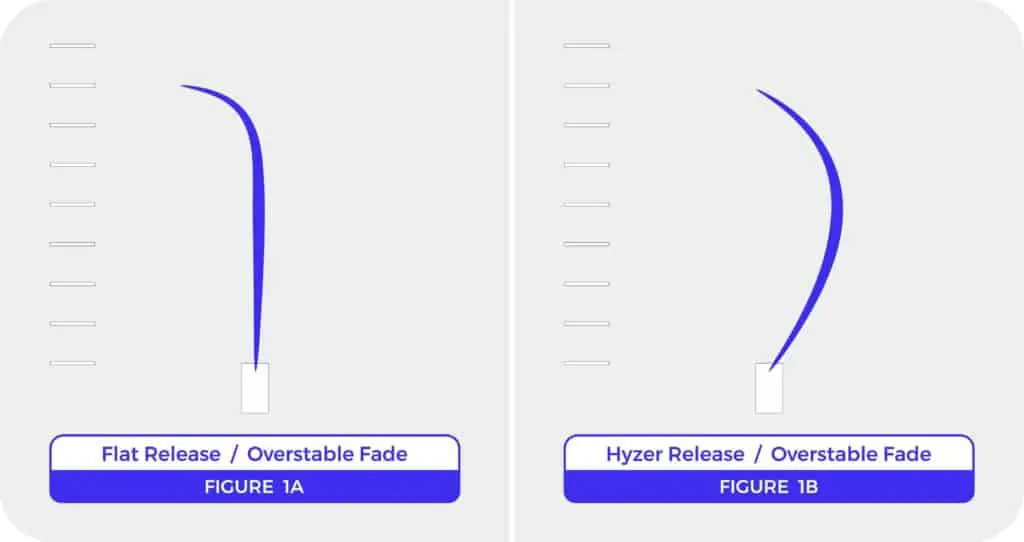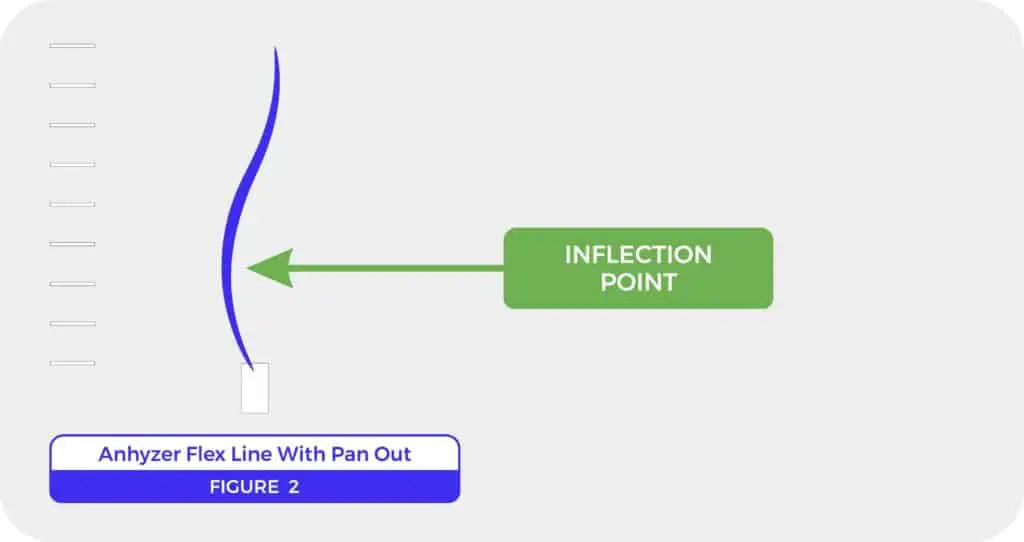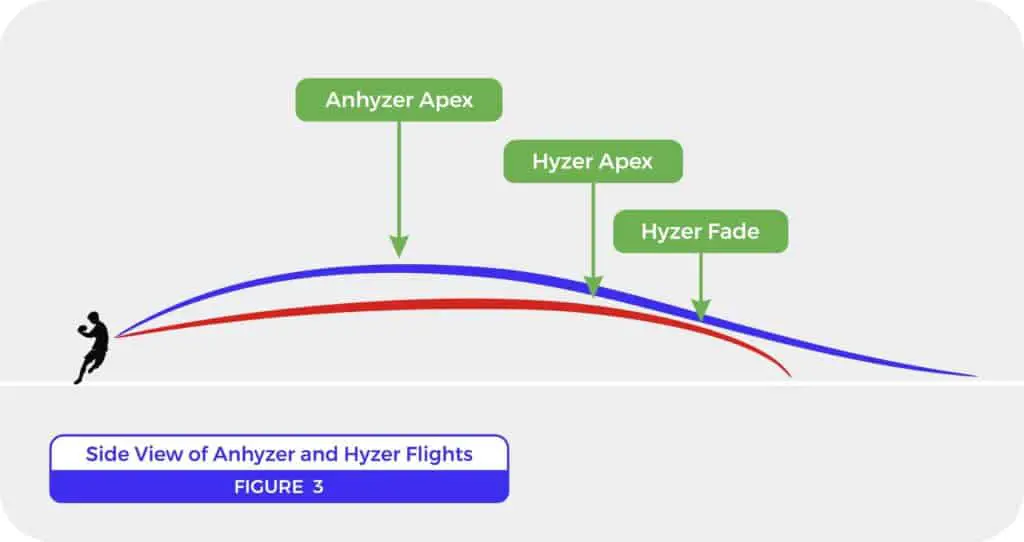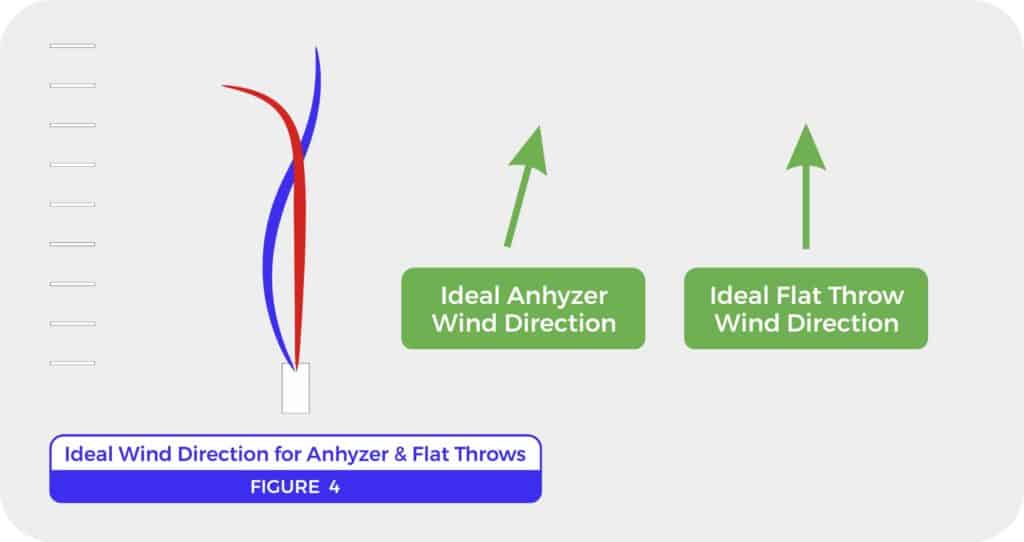You’re facing a choice between a hyzer line and an anhyzer line on a long par 5. Which flight path do you think will yield the farthest throw?
Setting aside some nuances that we’ll get to later, including rollers and skip shots. In most cases anhyzer flights will fly much farther than hyzer flights. You might wonder then why doesn’t everyone just throw anhyzer flights all the time. The thing is, hyzer flights are more accurate and reliable. So it’s a classic trade-off. Now let’s dissect this and understand how to make this choice.
Setting the Baseline
Before we get to the nuances, let’s establish the baseline case. Let’s stipulate that we’re throwing a driver disc that is 11 speed, 5 glide, -1 turn, and 2 fade. (If you’re not familiar with disc flight numbers, see this article)
It doesn’t matter which brand you prefer, every vendor has a driver fairly close to those numbers. Yes, of course one vendor’s 11 speed isn’t identical to another’s, but you’ll be able to easily apply this article to any similar disc. In fact, the principles here are the same whether the disc is 13 speed, or slower, say 9 speed.
For the first part of this article, let’s focus on two of the numbers: -1 turn and 2 fade. I’m using -1 turn in particular so that we can get the disc to “plane out” (to use the old-school term), or “pan out” (the modern term). This is critical because if we throw a disc with -2 or -3 turn, it will turn into a roller before we achieve the maximum air distance. Similarly, for this reason I’m not discussing a driver with more fade than 2 because it would cause the flight to dive left too soon (I’m assuming a right-handed backhand thrower, or lefty forehand, but you can easily translate this if you are lefty or throw righty forehand). To put it simply, since we want to achieve maximum glide time during the flight, we don’t want the disc falling off left or right. In other words, we want it to stay flat as long as possible.
Rephrasing the Question
And there’s a clue that tells us how to simplify this question. We can’t really throw it hyzer at all because in that case a 2 fade disc definitely will fall to the left—too soon. So for the hyzer test, we need to release the disc flat and get it to stay flat for about 80-90% of the flight before it fades left. A picture is worth 1000 words. So as Figure 1 shows, if you’ll forgive my lack of drawing skill and accept that these are theoretically adequate curves, we want to achieve flight path A not B. In the diagram, the tee pad is at the bottom. Flight path A is a perfectly flat throw that fades at the end. While flight path B would be achieved with a hyzer throw.

A disc with a 2 fade is considered slightly over-stable (OS), meaning it doesn’t fly perfectly straight at the end of the flight, but dives left. I don’t know if any vendors have a driver with zero fade. Since we know it will finish to the left, the best way to maximize the distance, assuming we put the same power behind both throws, is not to waste power with a hyzer flight that starts off going to the right. We must throw it flat (path A) so all of our power is applied directly on the line toward the hole. We are measuring the distance along the line from the tee pad to the hole—not the absolute distance if the disc flies diagonally away from the hole. Also, for now, I’m leaving out wind considerations. Obviously, if we are throwing into a 20 MPH headwind, some hyzer will be needed.
Answering the Question
Now that we’ve figured out we shouldn’t really throw hyzer for distance (except in a strong headwind), let’s compare the flat flight to a sophisticated anhyzer “flex” line. Figure 2 shows the flight path of this advanced throw. In this case, we actually do “waste” power aiming the throw a bit to the left. The first inflection point occurs at about 20-35% of the total distance. That’s when the -1 turn and the anhyzer angle we released the disc at begin to curve the disc back to the right, along our intended line.

Now here’s the hard part, especially for beginners. We need that curve at the inflection point to be very gentle and end up with the disc flying flat, possibly even nose-down for the remainder of the flight. Remember, we don’t want it to fall off to the right and head into the ground. It must stay flat. If we do this correctly, and it takes a lot of practice, we will witness one of the most beautiful aspects of disc flight. It turns out that the flat glide portion of the flight can more than compensate for the power we wasted going left at the beginning of the flight. In fact, the greatest distance throws even slide flat into the ground without fading left at all.
And I submit to you that when thrown properly, this anhyzer flex line can fly significantly farther, as measured toward the pin, than the flat (hyzer) throw. But it’s vital that you don’t let the right edge tip down too much after the inflection point. There are a few things that can make that difficult. Namely: the wind, the turn rating, and your experience. If you know your disc well and you’ve practiced this anhyzer flex flight, and you have a tailwind to aid the glide, then all is well. But before we consider some variables, let me offer you further rationale for why the anhyzer flight goes farther than the hyzer flight.
Comparing Anhyzer to Hyzer
Have a look at Figure 3, which is a side view of theoretical anhyzer and hyzer distance throws. I emphasize that these curves are arbitarily drawn to represent an idealized model. I could have drawn the anhyzer path flying shorter than the flat path to (falsely) “prove” the opposite argument. But please consider if the following line of reasoning justifies why the anhyzer throw flies farther. This is based on my years of experience and a recent test while researching this article, but I’m not a physicist so this logic may not be bulletproof.

The first thing to notice in Figure 3 is that the anhyzer flight is thrown higher than the flat flight. We can do this to increase the glide distance of the anhyzer flight. But it takes more of our throwing strength to get the disc up to that higher apex, so assuming equal throwing power, that apex occurs sooner in the flight than the apex of the flat flight. Imagine both of these throws are made to their optimal height. As you know, you definitely don’t want to throw a flat flight “too” high because then it will stall out and the hyzer fade will occur much too soon.
Second, notice that the flat flight doesn’t slide into the ground at the end but in this side view it drops off pretty quickly due to the hyzer fade that cannot be avoided with a 2 fade disc thrown flat.
Third, (here’s the physics part) when the anhyzer disc reaches its apex, it is flying faster than the flat throw is when it reaches it apex. How can we know this? When we release a disc, we exert force on the disc along the vertical axis (y vector) and the horizontal axis (x vector). Also, gravity applies negative force along the y vector and air resistance applies negative force along the x vector. The apex of the flight is when the acceleration due to gravity overtakes the vertical force we applied to throw the disc up. Both of these throws are released at the same velocity, and drag will immediately begin slowing the discs. Since the anhyzer apex occurs sooner in its flight, less drag has occurred up to that instant and so the anyzer throw, at its apex, is both higher and going faster than the flat throw at its apex. This accounts for the blue anhyzer line staying above the red flat throw line for the entire distance.
Does it matter if the wind is left-to-right vs. right-to-left?
Yes, of course it matters, but we don’t really get to choose the wind direction. In my experience training for and competing in world distance championships, where throws are made on an open field, I’d rather throw with a tailwind coming over my left shoulder than the same speed wind coming over my right shoulder. Let me explain.
A left-to-right tailwind is going to be most beneficial to the anhyzer flight after the inflection point. See Figure 4. When the tailwind is slightly left to right, it is directly along the line where the anhyzer throws achieves most of its glide, hopefully with nose down acting as a sail to catch that wind. And the best line of wind for the flat throw is straight down the field because that is the direction of the majority of the flight.

This does mean that at the beginning of the anhyzer throw, we are throwing slightly cross wind! However, the long glide that can be achieved with the anhyzer throw more than makes up for aiming cross wind in the first phase of the flight before the anhyzer apex.
What about Hyzer Flips?
Now that you see how to get maximum distance with a fancy anhyzer inflection, you could go back to the original question and ask, well, why not throw a hyzer flip with an understable disc, say a turn of -2 or -3, and then get it to pan out and fly the long anhyzer glide the rest of the way? Wouldn’t that be combining the best characterists of both?
My answer to that is “Holy Flight Control Batman! How did you do that?” Perhaps that would fly the farthest, but getting the disc to pan out after the hyzer flip would mean that the flight has two or three inflection points. That’s just too complex. But I’d love to see it.
Do Rollers Go Farther?
Now let’s talk about rollers, because after all, they are extreme anhyzer throws. Remember, in this article we chose a -1 turn disc for the baseline case. You can certainly throw them as backhand rollers but you just need to bend backward a bit and release it a bit more vertical than a natural throw. And there’s the catch. That means it won’t fly as far in the air as you would like and the roller will experience increased friction from the ground sooner (e.g. thick grass).
Well then, let’s just alter the baseline criteria and use a -2 or -3 turn disc for a roller and compare that to a -1 turn disc for an anhyzer flight. Now which goes farther, the roller or the anhyzer flight?
Amazingly, rollers go farther. I did an experiment on medium-thick grass, which is not ideal for a roller. I compared a 4 speed disc with a -3 turn for the roller vs. an 11 speed disc with a -1 turn and 2 fade (baseline disc) for the anhyzer flight. I made a very good anhyzer throw and an excellent roller. The roller won by over 40 feet! Yes, you read that right, a 4 speed roller disc easily beat an 11 speed anhyzer flight.
And it was beautiful to watch. Because the roller disc had a -3 turn, I was able to throw it a good distance in the air with an anyzer release. At the anhyzer apex, it began turning hard, dipping its right edge more and more toward the ground. By the time it touched the ground, about 120 feet downfield, it was standing up at a perfect 80 degree angle. And then the spin on the disc kicked in and acted as a second force along the x axis. That’s right, when the roller touches the ground, it still has your usual forward force despite some drag that has occurred (it might still be going 30-40 MPH), and it accelerates due to the spin of the disc. Of course, the grass quickly wears it down.
Here’s a conundrum. For maximum roller distance, you want the air time to be less than 30-40% of the total distance, but you also want the disc to go as far as possible in the air such that the understable disc is still able to stand up about 80 degrees when it touches the ground.
What about Skip Shots?
Now finally we can talk about skip shots. Let’s repose the question again. If you have a low ceiling and hard ground, which goes farther, hyzer or anhyzer? This time the flat throw or hyzer throw wins! Looking back at Figure 3, if we have a low ceiling, it restricts the height advantage of the anhyzer throw. Also, with a low ceiling and hard ground, a subtantial portion of the total distance can be from one or more flare skips as the overstable hyzer fade kicks in at the end of the flight.
Summary
In this article, we considered anhyzer distance vs. hyzer and found that flat throws fly farther than hyzer throws, but still not as far as optimal anhyzer throws. We considered the optimal wind direction, even though you won’t get to choose that! Then we talked about hyzer flips, rollers, and skip shots. Fly Freely!
About the Author
Scott Zimmerman was the 1982 World Frisbee Golf Champion, multiple-time World Overall Frisbee Champion, and threw an Aerobie across Niagara Falls and set four distance world records. His book “Chasing Disc Golf and the Overall Title” is available now with extremely favorable reviews at amazon.com. See chasingdiscgolf.weebly.com/